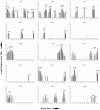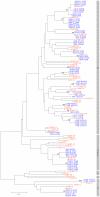Frequent detection of human adenovirus from the lower gastrointestinal tract in men who have sex with men
- PMID: 20593015
- PMCID: PMC2892480
- DOI: 10.1371/journal.pone.0011321
Frequent detection of human adenovirus from the lower gastrointestinal tract in men who have sex with men
Abstract
Background: The association between baseline seropositivity to human adenovirus (HAdV) type 5 and increased HIV acquisition in the Step HIV Vaccine Study has raised questions concerning frequency of acquired and/or persistent Adenovirus infections among adults at high risk of HIV-1 infection.
Methodology: To evaluate the frequency and pattern of HAdV shedding from the lower GI tract, we retrospectively tested rectal swabs for HAdVs in a cohort of 20 HSV-2 positive HIV-positive Peruvian men who have sex with men (MSM) undergoing rectal swabbing three times/week for 18 consecutive weeks, in a prospective study of HSV-2 suppression in HIV infection. Viral DNA was extracted and amplified using a sensitive multiplex PCR assay that detects all currently recognized HAdV types. Molecular typing of viruses was performed on selected samples by hexon gene sequencing. Baseline neutralizing antibody titers to HAdVs -5, -26, -35 and -48 were also assessed.
Principal findings: 15/20 individuals had HAdV detected during follow up. The median frequency of HAdV detection was 30% of samples (range 2.0% to 64.7%). HAdV shedding typically occurred on consecutive days in clustered episodes lasting a median of 4 days (range 1 to 9 days) separated by periods without shedding, suggesting frequent new infections or reactivation of latent infections over time. 8 of the 15 shedders had more than one type detected in follow-up. 20 HAdV types from species B, C, and D were identified, including HAdV-5, -26 and -48, HAdV types under development as potential vaccine candidates. 14/20 subjects were seropositive for HAdV-5; 15/20 for HAdV-26; 3/20 for HAdV-35; and 2/20 for HAdV-48. HAdV shedding did not correlate with CD4 count, plasma HIV-1 viral load, or titers to HAdV-5 or HAdV-35. The sole individual with HAdV-5 shedding was HAdV-5 seropositive.
Conclusions: HAdV shedding was highly prevalent and diverse, including types presently under consideration as HIV vaccine vectors. Subclinical HAdV infection of the GI tract is common among MSM in Peru; the prevalence of HAdV in the enteric tract should be evaluated in other populations. The association between ongoing recent enteric HAdV and the immune response to recombinant HAdV vaccines should be evaluated.
Conflict of interest statement
Figures


Similar articles
-
Enteric viruses in HIV-1 seropositive and HIV-1 seronegative children with diarrheal diseases in Brazil.PLoS One. 2017 Aug 30;12(8):e0183196. doi: 10.1371/journal.pone.0183196. eCollection 2017. PLoS One. 2017. PMID: 28854225 Free PMC article.
-
Outbreak of acute respiratory disease in China caused by B2 species of adenovirus type 11.J Clin Microbiol. 2009 Mar;47(3):697-703. doi: 10.1128/JCM.01769-08. Epub 2008 Dec 24. J Clin Microbiol. 2009. PMID: 19109466 Free PMC article.
-
An adenovirus type F41 outbreak in a pediatric bone marrow transplant unit: analysis of clinical impact and preventive strategies.Pediatr Infect Dis J. 2008 May;27(5):419-24. doi: 10.1097/INF.0b013e3181658c46. Pediatr Infect Dis J. 2008. PMID: 18382384
-
Animal Models in Human Adenovirus Research.Biology (Basel). 2021 Dec 1;10(12):1253. doi: 10.3390/biology10121253. Biology (Basel). 2021. PMID: 34943168 Free PMC article. Review.
-
Recent Advances in Novel Antiviral Therapies against Human Adenovirus.Microorganisms. 2020 Aug 22;8(9):1284. doi: 10.3390/microorganisms8091284. Microorganisms. 2020. PMID: 32842697 Free PMC article. Review.
Cited by
-
High prevalence and diversity of species D adenoviruses (HAdV-D) in human populations of four Sub-Saharan countries.Virol J. 2014 Feb 11;11:25. doi: 10.1186/1743-422X-11-25. Virol J. 2014. PMID: 24512686 Free PMC article.
-
Human adenovirus DNA polymerase is evolutionarily and functionally associated with human telomerase reverse transcriptase based on in silico molecular characterization that implicate abacavir and zidovudine.Front Bioinform. 2023 Jun 7;3:1123307. doi: 10.3389/fbinf.2023.1123307. eCollection 2023. Front Bioinform. 2023. PMID: 37351013 Free PMC article.
-
International seroepidemiology of adenovirus serotypes 5, 26, 35, and 48 in pediatric and adult populations.Vaccine. 2011 Jul 18;29(32):5203-9. doi: 10.1016/j.vaccine.2011.05.025. Epub 2011 May 25. Vaccine. 2011. PMID: 21619905 Free PMC article.
-
Molecular evolution of human species D adenoviruses.Infect Genet Evol. 2011 Aug;11(6):1208-17. doi: 10.1016/j.meegid.2011.04.031. Epub 2011 May 5. Infect Genet Evol. 2011. PMID: 21570490 Free PMC article.
-
Isolation of a recombinant simian adenovirus encoding the human adenovirus G52 hexon suggests a simian origin for human adenovirus G52.J Virol. 2024 Apr 16;98(4):e0004324. doi: 10.1128/jvi.00043-24. Epub 2024 Mar 18. J Virol. 2024. PMID: 38497664 Free PMC article.
References
-
- Buimovici-Klein E, Lange M, Ong KR, Grieco MH, Cooper LZ. Virus isolation and immune studies in a cohort of homosexual men. J Med Virol. 1988;25:371–385. - PubMed
-
- Durepaire N, Ranger-Rogez S, Gandji JA, Weinbreck P, Rogez JP, et al. Enteric prevalence of adenovirus in human immunodeficiency virus seropositive patients. J Med Virol. 1995;45:56–60. - PubMed
Publication types
MeSH terms
Substances
Grants and funding
LinkOut - more resources
Full Text Sources
Other Literature Sources
Research Materials

